
Professional-mode flash glucose monitoring may help improve glucose control in type 2 diabetics, presenting a possible approach to personalized care, according to a recent study.
“Our findings suggest that professional-mode flash glucose monitoring can be implemented in a pragmatic primary care environment,” said researchers. “Although there was no change in glycated haemoglobin (HbA1c) at 12 months, the improved time in target range might reflect the potential of the technology to support personalised clinical care by providing insights into glycaemic profiles for some people with type 2 diabetes (T2D).”
Almost 300 adult T2D patients were randomly assigned to receive either a professional-mode flash glucose monitoring device (n=149) or usual care (n=150). HbA1c levels were significantly lower in the former group at the 6-month follow-up after enrolment (difference, –0.5 percent, 95 percent confidence interval [CI], –0.8 to –0.3; p=0.0001). [Lancet Diabetes Endocrinol 2020;8:17-26]
However, this discrepancy was attenuated by month 12 (flash monitoring vs usual care: 8.2 percent vs 8.5 percent; difference, –0.2 percent; 95 percent CI, –0.5 to 0.05; p=0.11).
“Use of professional-mode flash glucose monitoring every 3 months over a 12-month period in adults with T2D in primary care did not significantly improve HbA1c at 12 months compared with usual care,” the researchers said.
Despite this, the intervention still yielded significant important benefits. By month 12, for example, patients in the flash-monitoring group spent more time in the target HbA1c range than their usual-care comparators (54.8 percent vs 46.9 percent; p=0.006). At baseline, patients in either group spent 41.1 percent of time in the target range.
The flash monitoring device was also safe, leading to a prevalence rate of level-2 hypoglycaemia not significantly higher than that in the usual care group (33 percent vs 31 percent). Level-2 hypoglycaemia was defined as breaching the <3 mmol/L threshold on two consecutive monitor measurements 15 minutes apart.
There were likewise no documented cases of severe hypoglycaemia and treatment-related deaths; the single mortality in the study was deemed to be due to complications from myocardial infarction with many comorbidities.
“One important issue relates to how often and for how long a person with T2D should wear and use a glucose sensor,” the researchers said. “A trade-off exists between providing enough glucose data at a time when both [the patient] and the clinician are ready to engage with the data, the intrusiveness of the technology and the cost.
“Perhaps professional mode glucose monitoring might be best used as an occasional diagnostic tool leading to a teaching moment, deployed when both the person with T2D and their clinician are ready. Determining the optimal readiness and timing for use of professional-mode glucose monitoring outside trial settings will have important cost implications,” they added.